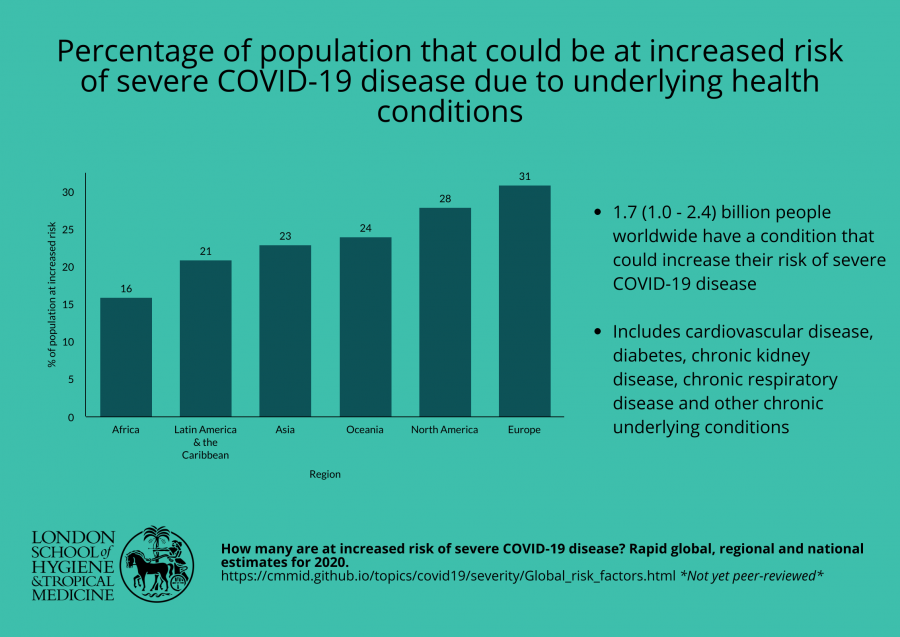One in five people globally could be at increased risk of severe COVID-19 disease through underlying health conditions
17 April 2020 London School of Hygiene & Tropical Medicine London School of Hygiene & Tropical Medicine https://lshtm.ac.uk/themes/custom/lshtm/images/lshtm-logo-black.png
Caption: risk of severe COVID-19 disease. Credit: LSHTM
Based on current guidelines, 1.7 (1.0 – 2.4) billion people worldwide have a condition that could increase their risk of severe COVID-19 disease, according to new preliminary estimates from the London School of Hygiene & Tropical Medicine. The rapid assessment could support countries identify who could be eligible for shielding and potentially vaccination.
The work suggests that the share of the population at increased risk ranges from 16% in Africa to 31% in Europe, with considerable variation between countries. The higher proportion in Europe is due to many older individuals living with cardiovascular disease (CVD), diabetes, chronic kidney disease (CKD) and chronic respiratory disease (CRD). Several African countries with high HIV/AIDS prevalence, such as South Africa, were also estimated to have high shares of the population at possible increased risk, as were several small island nations with high levels of diabetes.
Currently the criterion for who is at ‘increased risk’ (UK terminology) or ‘higher risk’ (US terminology) is essentially binary: whether or not a person has a condition that is on a list of diseases that may be associated with severe COVID-19 disease requiring hospitalisation. However, the degree of risk for individuals who meet the criterion will vary widely. The team behind these estimates call for urgent further work to quantify and analyse the risks associated with the different underlying conditions so that protection measures can be targeted at those at greatest risk.
Dr Andy Clark, lead author of the study, said: “Protecting vulnerable individuals and reducing pressure on health systems is crucial during this pandemic. Our preliminary estimates are a useful first step, providing a rapid assessment of how many people could be at increased risk according to current guidelines. However, more work needs to be done to understand who among them are at greatest risk. Some will be very vulnerable, but for others the increased risk may be quite modest.”
The study combines evidence from large international databases and new analysis of large multimorbidity studies. The team estimated the number of individuals at increased risk of severe COVID-19 disease by age, sex and country, based on data from the Global Burden of Disease (GBD) study for 2017 and United Nations population estimates for 2020. The team identified 11 categories of underlying conditions relevant to COVID-19 disease by mapping conditions listed in GBD, to the guidelines published by WHO and public health agencies in the UK and US. They also calculated the number of individuals without an underlying condition that could be considered at increased risk because of their age, using thresholds from 50-70 years.
Dr Rosalind Eggo, member of the research team, said: “The risk of severe COVID-19 disease is known to be higher in older individuals and those with underlying health conditions. As the COVID-19 pandemic evolves, countries are considering policies of ‘shielding’ the most vulnerable. However, there is currently very limited evidence on the number of individuals that might need that type of intervention. We aimed to make a start on plugging that knowledge gap. While preliminary, we hope this work supports countries around the world in their efforts to design effective interventions quickly.”
The researchers acknowledge limitations of their work. For this rapid assessment, they relied heavily on the best available global estimates on the prevalence of underlying conditions in different countries. These estimates capture the full spectrum of disease for some of the underlying conditions considered, so are likely to include many undiagnosed cases with a much smaller level of increased risk. Also, their estimates will not have captured individuals that do not have any of the 11 underlying conditions considered, but do have other possible risk factors e.g. smoking, BMI 40+. Including these additional risk factors is unlikely to have a substantial impact on their current estimates but may be important to consider when trying to understand the degree of risk for specific individuals.
The researchers have developed a spreadsheet tool that can be used for rapid assessment and visualisation of the estimated number and percentage of country populations targeted under different shielding policies. This allows different health conditions to be included/excluded, different age thresholds to be assessed, and different choices about key assumptions.
The team say the next steps should be robust analyses of the risks associated with different underlying conditions so that countries can identify the highest risk groups and develop targeted shielding policies to mitigate the effects of the COVID-19 pandemic.
Research
If you enjoyed this article and would like to build a career in global health, we offer a range of MSc programmes covering health and data, infectious and tropical diseases, population health, and public health and policy.
Available on campus or online, including flexible study that works around your work and home life, be part of a global community at the UK's no.1 public health university.